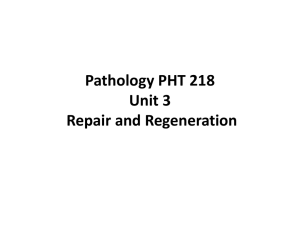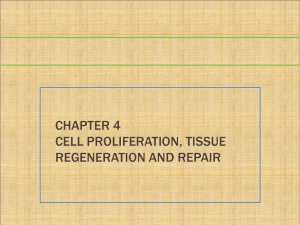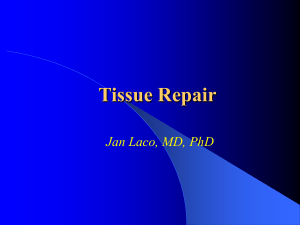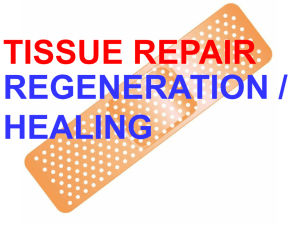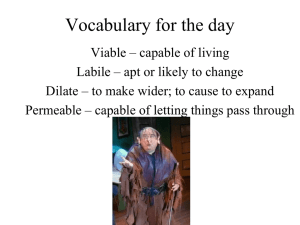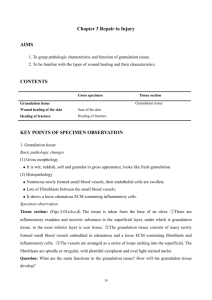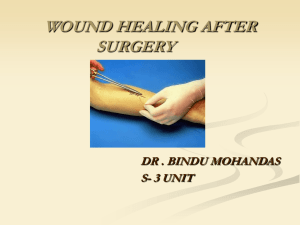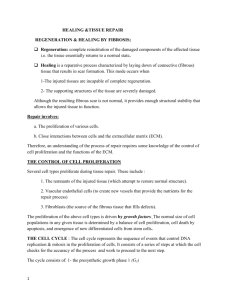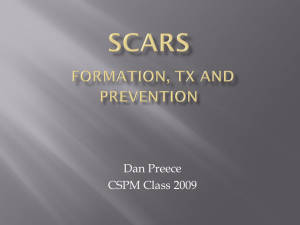PPT
advertisement
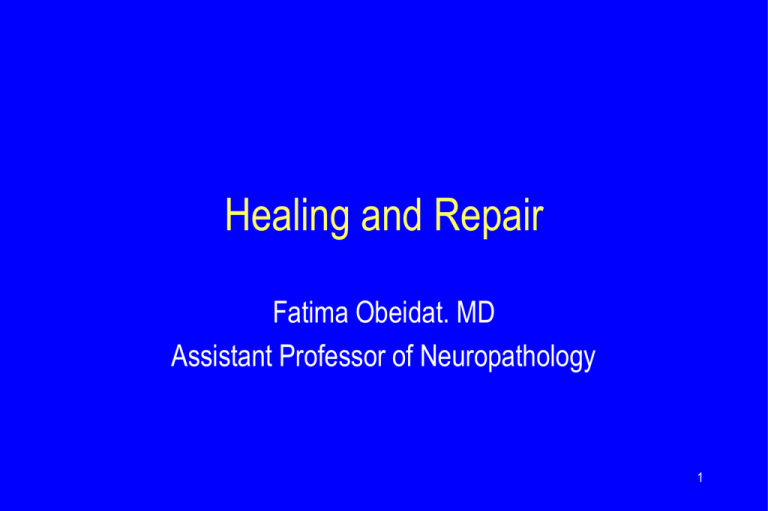
Healing and Repair Fatima Obeidat. MD Assistant Professor of Neuropathology 1 Repair: (healing);Refers to the restoration of tissue function and architecture after an injury and it has two types : a. Regeneration: It occurs in tissues that are able to replace the damaged cells,so return to a normal state. It is the typical response in dividing cells notably the liver. b. Scar formation: Occurs by the laying down fibrous tissue, a process that results in scar formation and occurs 1. If the injured tissues are incapable of regeneration 2, or if the supporting structures of the tissue are severely damaged 2 Fibrosis : Extensive deposition of collagen that occurs in the lungs, liver, kidney, as a result of chronic inflammation, or in the myocardium after infarction NOTES 1: Although the fibrous scar cannot perform the function of lost parenchymal cells, it provides enough structural stability that the injured tissue is usually able to function. 2. After many common types of injury, both regeneration and scar formation contribute in varying degrees to repair and both processes involve the proliferation of various cells and close interactions between cells and the ECM 3 so several cell types proliferate during tissue repair including 1. The remnants of the injured tissue 2. Vascular endothelial cells (to create new vessels) 3. Fibroblasts (the source of the fibrous tissue) Proliferative Capacities of Tissues : 3 types of tissues I. Labile (continuously dividing) tissues. : Examples include a. Hematopoietic cells in the bone marrow b. The majority of surface epithelia, such as the stratified squamous surfaces of the skin, oral cavity,and cervix 4 c. The cuboidal epithelia of the ducts draining exocrine organs(e.g., salivary glands, pancreas, biliary tract) d . The columnar epithelium of the gastrointestinal tract and uterus e . The transitional epithelium of the urinary tract 2. Stable tissues.: - Are quiescent and have only minimal replicative activity in their normal state; however, these cells are capable of proliferating in response to injury or loss of tissue mass a. The parenchyma of liver, kidney, and pancreas 5 . b. Endothelial cells, fibroblasts, and smooth muscle cells; ,the proliferation of which is important in wound healing. Note: With the exception of liver, stable tissues have a limited capacity to regenerate after injury III. Permanent tissues.: - The cells are considered to be terminally differentiated and non-proliferative in postnatal life and Include most neurons and cardiac muscle cells , injury to brain or heart is irreversible and results in a scar 6 Note : Limited stem cell replication occurs in some areas of the adult brain, and there is some evidence that cardiac stem cells may proliferate after myocardial necrosis. Nevertheless, whatever the proliferative capacity may exist in these tissues, it is insufficient to produce tissue regeneration after injury - Skeletal muscle is usually classified as a permanent tissue, but satellite cells attached to the endomysial sheath provide some regenerative capacity for this tissue. - In permanent tissues, repair is typically dominated by scar formation 7 The Extracellular Matrix in Tissue Repair: its components I. Fibrous structural proteins II. Water-hydrated gels III. Adhesive glycoproteins I. Fibrous structural proteins: collagens and elastin A. Collagens 1- Fibrillar collagens ( types I, II, III, and V),they form a major proportion of the connective tissue in scars - The tensile strength of the fibrillar collagens derives from their cross-linking, catalyzed by the enzyme lysyl-oxidase 8 which is dependent on vitamin C; so vitamin C deficiency leads to skeletal deformities, easy bleeding and poor wound healing - Genetic defects in fibrillar collagens cause diseases such as osteogenesis imperfecta and Ehlers-Danlos syndrome 2. Non-fibrillar collagens include: a. Type IV present in basement membrane b. Type IX: components of intervertebral disks c. Type VII in dermal-epidermal junctions 9 B. Elastin : Confers ability to tissues to recoil and return to a baseline structure after physical stress and this is important in (aorta) and in the uterus, skin, and ligaments - elastic fibers consist of core of elastin surrounded by a mesh-like network of fibrillin glycoprotein - Defects in fibrillin synthesis lead to skeletal abnormalities and weakened aortic walls (as in Marfan syndrome) III.Adhesive Glycoproteins : Fibronectin and Laminin A1 - Tissue Fibronectins : forms fibrillar aggregates at wound healing site 10 A2. Plasma fibronectin binds to fibrin within the blood clot that forms in a wound, providing the substratum for ECM deposition and re-epithelialization. B. Laminin: Is the most abundant glycoprotein in basement membrane , it connects cells to type IV collagen Steps in Scar Formation I. Formation of new blood vessels II. Migration and proliferation of fibroblasts and deposition of connective tissue, III. Maturation and reorganization of the fibrous tissue (remodeling) to produce the stable fibrous scar 11 I. Formation of new blood vessels : is critical in : a. In healing at sites of injury, b. development of collateral circulations at sites of ischemia c. In allowing tumors to increase in size - Much work done to understand the mechanisms of angiogenesis, and therapies to either augment the process (to improve blood flow to a heart affected by coronary atherosclerosis) or inhibit it (to decrease tumor growth ) are being developed. 12 Types of new blood vessel formationangiogenesis 1. Angiogenesis involves sprouting of new vessels from existing ones and consists of the following steps a. Vasodilation occurring in response to NO (nitric oxide) and increased permeability induced by VEGF b. Migration of endothelial cells toward the area of tissue injury and Proliferation of endothelial cells d. Remodeling into capillary tubes e. Recruitment of (pericytes) for small capillaries and smooth muscle cells for larger vessels) to form the mature vessel 13 Angiogenesis f. Suppression of endothelial proliferation and deposition of the basement membrane - Several growth factors contribute to angiogenesis 1. The VEGF family of growth factors a. VEGF-A is generally referred to as VEGF and is the major inducer of angiogenesis after injury and in tumors b. VEGF-B and PlGF involved in vessel development in the embryo c. VEGF-C and -D stimulate lymphangiogenesis - Of the many inducers of VEGF 15 a. Hypoxia is the most important b. Platelet-derived growth factor (PDGF)and , TGF-α, and TGF-β (transforming growth factor). Functions of VEGFs 1. Stimulates migration and proliferation of endothelial cells 2. Promotes vasodilation by stimulating the production of NO 3. and contributes to the formation of the vascular lumen Note: Antibodies against VEGF are approved for the treatment of some tumors that depend on angiogenesis 16 2. The FGF family of growth factors : The best characterized are FGF-1 (acidic ) and FGF-2 (basic), FGF-2 :. 1.Stimulates the proliferation of endothelial cells and promotes the migration of macrophages and fibroblaststs the damaged area 2. It stimulates epithelial cell migration to cover wounds. 3. Angiopoietins : Ang1 and Ang2 play a role in angiogenesis and the structural maturation of new vessels - Ang1 interacts with a tyrosine kinase receptor on endothelial cells called Tie2. 17 - Newly formed vessels need to be stabilized by pericytes recruited by and smooth muscle cells by PDGF and by the deposition of connective tissue by TGG-B 2.Vasculogenesis :- Is the growth of blood vessels during embryonic development and in vasculogenesis vessels are formed either a. by the coalescence of endothelial precursors( angioblasts) b. Or from endothelial progenitors in the adult that are derived from bone marrow stem cells and circulate and the contribution of these cells to angiogenesis in adults is not definitely established. 18 II- Activation of Fibroblasts and Deposition of Connective Tissue:- Laying down of connective tissue in the scar has two steps: 1. Migration and proliferation of fibroblasts into the site of injury 2. Deposition of ECM proteins produced by these cells - The recruitment and activation of fibroblasts are driven by many growth factors, including PDGF, FGF-2 and TGF-β NOTE:- Repair begins within 24 hours of injury by the emigration and proliferation of fibroblasts and the 19 Granulation tissue and Fibrosis and endothelial cell proliferation. - By 3 to 5 days, the specialized granulation tissue is apparent and the term granulation tissue derives from its granular gross appearance and its histologic appearance is characterized by proliferation of fibroblasts and new thin-walled, delicate capillaries in loose ECM, often with admixed inflammatory cells - As healing progresses, the number of proliferating fibroblasts and new vessels decreases; and the fibroblasts progressively assume a more synthetic phenotype, so there is increased deposition of ECM. 21 -Collagen synthesis is critical to the development of strength in a healing wound site and its synthesis by fibroblasts begins early (days 3 to 5) and continues for several weeks, depending on the size of the wound. - Net collagen accumulation, depends not only on increased synthesis but also on diminished collagen degradation - Ultimately, there is progressive vascular regression and the granulation tissue evolves into a scar composed of largely inactive spindle-shaped fibroblasts, and dense collagen, 22 - Growth Factors Involved in ECM Deposition and Scar Formation .: TGF-B1, PDGF, FGF2 . Transforming growth factor-β (TGF-β): - Belongs to a family consists of (TGF-β1, -β2, β3) -TGF-β1 is referred to as TGF-β a. In the context of inflammation and repair. 1. It stimulates production of collagen, fibronectin and proteoglycans 2.- It inhibits collagen degradation by both decreasing metalloproteinase synthesis and increasing the activity of tissue inhibitors of proteinases known as TIMPs 23 b. TGF-β is an anti-inflammatory cytokine that limit and terminate inflammatory response by inhibiting lymphocyte proliferation and the activity of other leukocytes III. Remodeling of Connective Tissue - After its synthesis , the connective tissue in the scar continues to be modified and remodeled and thus the outcome of the repair process is a balance between synthesis and degradation of ECM - The degradation of ECM components is accomplished by a family of matrix metalloproteinases (MMPs), which are dependent on zinc ions for their activity and include 24 1. Interstitial collagenases that cleave fibrillar collagen (MMP-1,2, 3); 2. Gelatinases (MMP-2 and -9), which degrade amorphous non-fibrillar collagen and fibronectin; 3. Stromelysins (MMP-3, 10, and 11) which degrade laminin proteoglycans, fibronectin, and amorphous collagen - MMPs synthesis is stimulated by PDGF and IL-1&TNF but synthesis is inhibited by TGF-B . - MMPs are secreted as precursors that should be activated by plasmin 25 - Activated MMPs can be inhibited by specific tissue inhibitors of metalloproteinases (TIMPs) produced by mesenchymal cells. - Thus, during scarring, MMPs are activated to remodel the deposited ECM, and then their activity is shut down by the TIMPs. FACTORS THAT INFLUENCE TISSUE REPAIR 1. Infection is clinically the most important cause of delay in healing; it prolongs inflammation and increases the local tissue injury 26 Matrix metalloproteinase regulation 2. Nutrition:; protein deficiency, and especially vitamin C deficiency inhibit collagen synthesis and retard healing 3. Mechanical variables such as increased local pressure like ascitis may cause wounds in the abdomen to pull apart, or dehisce. 4. Poor perfusion, due either to arteriosclerosis or to obstructed venous drainage (varicose veins), also impairs healing 5.. Foreign bodies such as fragments of steel, glass, or even bone impede healing. 28 Aberrations of cell growth and ECM production . A.Keloid: The accumulation of exuberant amounts of collagen can give rise to prominent, raised scars and there appears to be a heritable predisposition to keloid formation, and the condition is more common in AfricanAmericans. B."proud flesh : Exuberant granulation tissue that protrudes above the level of the surrounding skin and prevents re-epithelialization and requires cautery or surgical resection of the granulation tissue. one of the commonest sites is the ear at site of ear 29 keloid Healing of Skin Wounds :- Is a process that involves both epithelial regeneration and formation of connective tissue scar and it occurs by first or second intention. 1. Healing by first intention (referred to as primary union) - Is the healing of a clean, uninfected surgical incision approximated by surgical sutures and characterized by : a. Focal disruption of epithelial basement membrane continuity b. Causes death of few epithelial and connective tissue cells; therefore epithelial regeneration is the principal mechanism of repair 31 c. A small scar is formed, d. But there is minimal wound contraction 2. Healing by second intention(secondary union) - It occurs when there is extensive tissue loss , in large wounds, abscess formation, ulceration, and infarction - The repair process involves a combination of regeneration and scarring and it is characterized by a. Intense inflammatory reaction b. Development of abundant granulation tissue, with accumulation of ECM and formation of a large scar, 32 c. Wound contraction mediated by myofibroblasts - Secondary healing differs from primary healing by:: a. A larger clot or scab rich in fibrin and fibronectin forms at the surface of the wound b. Inflammation is more intense because large tissue defects have a greater volume of necrotic debris,a nd exudate that must be removed and consequently, large defects have a greater potential for secondary, inflammation-mediated, injury c. Larger defects require a greater volume of granulation tissue to fill in the gaps and provide the underlying 33 framework for the regrowth of tissue epithelium. d. A greater volume of granulation tissue generally results in a greater mass of scar tissue e. It involves wound contraction mediated,by myofibroblasts, which are modified fibroblasts exhibiting ultrastructural and functional features of contractile smooth muscle cells so within 6 weeks large skin defects may be reduced to 5% to 10% of their original size Wound Strength:- Carefully sutured wounds have approximately 70% of the strength of normal skin, because of placement of sutures. 34 - When sutures are removed, usually at 1 week, wound strength is approximately 10% of that of unwounded skin, but this increases rapidly over the next 4 weeks. -The recovery of tensile strength results from collagen synthesis exceeding degradation during the first 2 months, and from structural modifications of collagen (e.g., crosslinking, increased fiber size) when synthesis declines at later times. - Wound strength reaches approximately 70% to 80% of normal by 3 months and does not improve substantially beyond that point. 35

